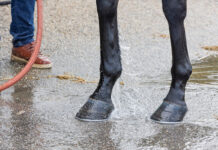

A: What a fascinating question! The role of exercise is a very hot topic on both the horse AND the human side, with scientists looking at all sorts of things including its effect on weight loss, appetite, inflammation, insulin resistance, and other outcomes. Here are the conclusions of a few research articles I found which speak directly to your concern.
- Insulin sensitivity returned to pre-exercise values by 9 days postexercise in the obese-exercised and lean-exercised groups. The results of this study suggest that improvement in insulin sensitivity occurs in obese mares without a long interval of exercise training (worked at a trot to a HR of not more than 140bpm for 30 min in a round pen) and in the absence of a change in bodyweight.1
- The fact that the beneficial effect of increased insulin sensitivity after acute exercise diminishes quickly in horses and no long-term effects on insulin sensitivity after chronic exercise have as yet been found in horses, implies that exercise should be performed on a regular basis in horses to retain the beneficial effect of improved insulin sensitivity.2
- Insulin resistance in equids has been associated with obesity and predisposition to laminitis. Regular physical activity may mitigate risk of these conditions via enhancement of insulin sensitivity and/or control of bodyweight.3
- Body weight and fat mass decreased by 4% and 34% respectively, compared with pre-exercise values, with similar losses during low and higher-intensity training. There was no effect of exercise training on subcutaneous fat thickness, plasma hormone and lipid concentrations, or minimal model parameters of glucose and insulin dynamics.Results suggest that moderate exercise training without concurrent dietary restriction does not mitigate insulin resistance in overweight or obese horses. A more pronounced reduction in adiposity or higher volume or intensity of exercise may be necessary for improvement in insulin sensitivity in such horses.4
- Exercise has been shown to reduce insulin resistance and suppress inflammation, and dietary manipulation can significantly affect insulin sensitivity.5
- In all, 31 stabled horses underwent three different exercise regimens: turnout, light exercise (60 minutes at the walk, three days a week, plus six hours of turnout on three days), and moderate exercise (90 minutes of walk and trot up to five days a week), while being fed a diet containing 60% concentrate . . . Insulin sensitivity was higher during periods of moderate and light physical activity as compared with turnout. These results indicate that turnout alone may not be adequate to improve insulin sensitivity in horses fed high amounts of concentrate.6
- Fourteen days of low intensity (10 min walking and 5 min trotting) exercise significantly decreased plasma inflammatory markers in all ponies such that it was no longer increased compared to normal. Regular low intensity exercise appears to have an anti-inflammatory effect, which is possibly greater in previously laminitic ponies and so may be beneficial in reducing this putative risk factor in pasture-associated laminitis. 7
Okay, so here’s what I take away from all these studies. Exercise is an excellent tool to help manage weight, as long as your horse is sound. Since your mare is already in a good training and condition program, that doesn’t appear to be an issue. The low to moderate intensity workout you’re currently doing may be sufficient, although I would push for daily exercise since these studies show simple turnout isn’t the equivalent of controlled movement. Diet appears to be an important factor as well in achieving a healthy weight, so if you haven’t discussed nutrition with your veterinarian (as well as the possibility of your mare having Equine Metabolic Syndrome or insulin resistance) then now’s the time to do so. Keep up the good work!
1. Effect of short-term exercise training on insulin sensitivity in obese and lean mares. Powell DM, Reedy SE, Sessions DR, Fitzgerald BP.Equine Vet J Suppl. 2002 Sep;(34):81-84.
2. The effect of long-term exercise on glucose metabolism and peripheral insulin sensitivity in standardbred horses. De Graaf-Roelfsema E, van Ginneken ME, van Breda E, et al. Equine Vet J. Suppl. 2006 Aug;(36):221-225.
3. Effects of short-term training on insulin sensitivity and skeletal muscle glucose metabolism in standardbred horses. Stewart-Hunt L, Geor RJ, McCutcheon LJ. Equine Vet J Suppl. 2006 Aug;(36):226-232.
4. Effects of exercise training on adiposity, insulin sensitivity, and plasma hormone and lipid concentrations in overweight or obese, insulin-resistant horses. Carter RA, McCutcheon LJ, Valle E, Meilahn EN, and Geor RJ. Am J Vet Res. 2010 Mar;71(3):314-321.
5. Endocrinopathic laminitis: reducing the risk through diet and exercise. Menzies-Gow NJ. Vet Clin North Am Equine Pract. 2010 Aug;26(2):371-378.
6. Comparison of insulin sensitivity of horses adapted to different exercise intensities. Turner SP, Hess TM, Treiber K, et al. J Eq Vet Sci. 2011 Nov;31(11):645-649.
7. The effect of exercise on plasma concentrations of inflammatory markers in normal and previously laminitic ponies. Menzies-Gow NJ, Wray H, Bailey SR, et al. Equine Vet J. 2013 Jul 2 (epub).






